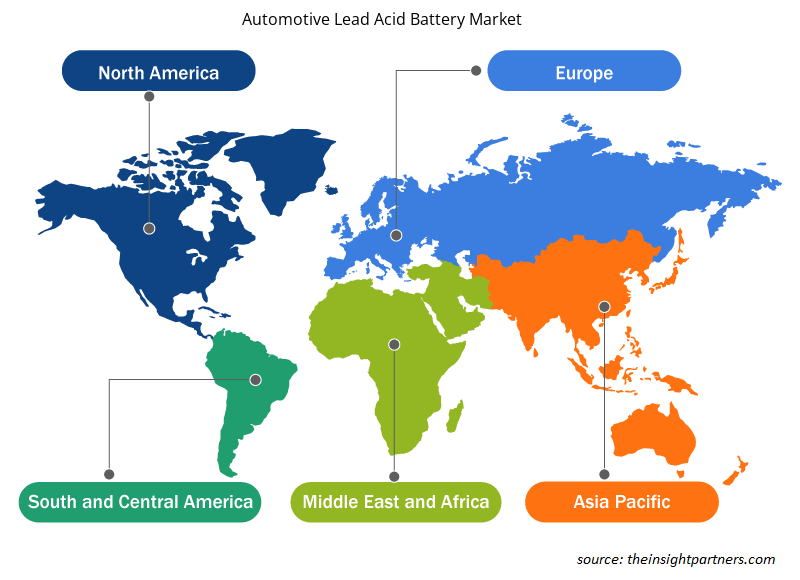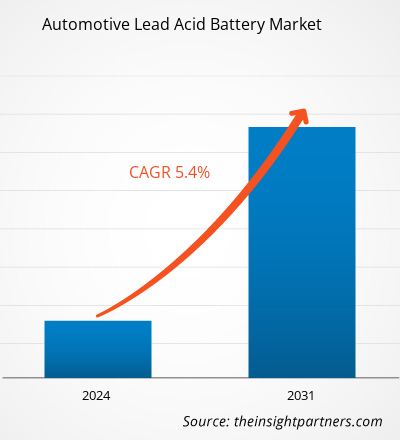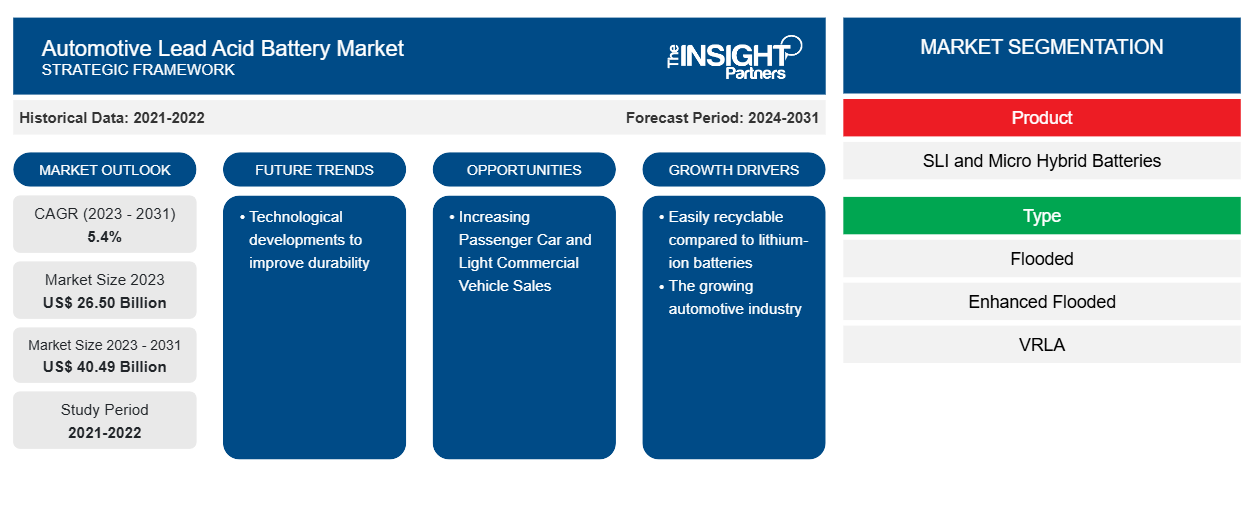Der Markt für Bleibatterien für Kraftfahrzeuge soll von 26,50 Milliarden US-Dollar im Jahr 2023 auf 40,49 Milliarden US-Dollar im Jahr 2031 wachsen; von 2023 bis 2031 wird eine durchschnittliche jährliche Wachstumsrate von 5,4 % erwartet. Die technologische Entwicklung zur Verbesserung der Haltbarkeit dürfte ein wichtiger Trend auf dem Markt sein.CAGR of 5.4% from 2023 to 2031. Technological development to improve durability is anticipated to be a key trend in the market.
Marktanalyse für Blei-Säure-Batterien für Kraftfahrzeuge
Im Vergleich zu anderen Arten wiederaufladbarer Batterien sind Bleibatterien günstiger. Die Selbstentladungsrate dieser Batterie beträgt etwa 40 % pro Jahr. Eine Bleibatterie funktioniert sowohl bei hohen als auch bei niedrigen Temperaturen einwandfrei. Die in diesen Batterien verwendete Technologie ist ausgereift. Bei ordnungsgemäßer Verwendung kann eine Bleibatterie lange halten und zuverlässig ihren Dienst verrichten. Bleibatterien können große Stoßströme liefern, was sie ideal für Anwendungen macht, die einen schnellen Stromstoß erfordern, wie z. B. Starterbatterien für Kraftfahrzeuge. Daher wird erwartet, dass die Nachfrage nach Bleibatterien für Kraftfahrzeuge im Prognosezeitraum steigen wird.
Branchenübersicht über den Markt für Blei-Säure-Batterien für Kraftfahrzeuge
Eine Blei-Säure-Autobatterie ist ein wiederaufladbares Gerät, das elektrische Energie als chemische Energie speichert. Sie besteht aus vielen in Reihe geschalteten Zellen, von denen jede eine Reihe von Bleidioxid- und Bleischwammplatten enthält, die in eine Schwefelsäurelösung getaucht sind. Blei-Säure-Batterien funktionieren in einer Vielzahl von Klimasituationen effektiv . Sie haben eine hohe Startleistung und liefern selbst bei extremen Temperaturen ausreichend Startstrom. Diese Eigenschaft macht Blei-Säure-Batterien zu einer ausgezeichneten Wahl für Autos sowohl in kalten als auch in heißen Klimazonen. Daher wird erwartet, dass die Nachfrage nach Blei-Säure-Batterien im Prognosezeitraum steigen wird.
Passen Sie diesen Bericht Ihren Anforderungen an
Sie erhalten kostenlose Anpassungen an jedem Bericht, einschließlich Teilen dieses Berichts oder einer Analyse auf Länderebene, eines Excel-Datenpakets sowie tolle Angebote und Rabatte für Start-ups und Universitäten.
-
Holen Sie sich die wichtigsten Markttrends aus diesem Bericht.Dieses KOSTENLOSE Beispiel umfasst eine Datenanalyse von Markttrends bis hin zu Schätzungen und Prognosen.
Treiber und Chancen auf dem Markt für Bleibatterien für Kraftfahrzeuge
Bleibatterien sind im Vergleich zu Lithium-Ionen-Batterien leicht recycelbar, was das Marktwachstum fördert.
Beim Batterierecycling wird die Schwefelsäure aus gebrauchten Batterien sorgfältig entfernt und neutralisiert. Dieses Verfahren begrenzt den Ausstoß gefährlicher Schwefelsäure in die Umwelt und verringert die Gefahr einer Boden- und Wasserverschmutzung. Lithium-Ionen-Batterien enthalten keine giftigen Chemikalien, Blei-Säure-Batterien hingegen schon. Beide Batterietypen sind recycelbar. Blei-Säure-Batterien lassen sich jedoch in den meisten Teilen der Welt leichter recyceln als Lithium-Ionen-Batterien. Etwa 95 % der Materialien in Blei-Säure-Batterien sind recycelbar, was sie zu einer umweltfreundlichen Wahl macht. Daher wird erwartet, dass die Nachfrage nach Blei-Säure-Batterien im Prognosezeitraum steigen wird.
Steigende Pkw- und Nutzfahrzeugverkäufe
Laut dem in der Economic Times veröffentlichten Artikel erreichte der Pkw-Großhandel in Indien im Geschäftsjahr 2023–24 einen neuen Höchststand von 42.187.46 Einheiten. Darüber hinaus erreichten Chinas Nutzfahrzeugexporte laut der China Association of Automobile Manufacturers im Januar 2024 74.000 Einheiten. Bleibatterien werden für Start, Beleuchtung und Zündung (SLI) in einem Automobil bevorzugt. Daher wird erwartet, dass der steigende Absatz von Personenkraftwagen und leichten Nutzfahrzeugen die Nachfrage nach Bleibatterien im Prognosezeitraum steigern wird.SLI) in an automobile. Thus, increasing sales of passenger and light
Segmentierungsanalyse des Marktberichts für Blei-Säure-Batterien für Kraftfahrzeuge
Die Schlüsselsegmente, die zur Ableitung der Marktanalyse für Bleibatterien für Kraftfahrzeuge beigetragen haben, sind Produkt und Endbenutzer.
- Je nach Produkt wird der Markt in SLI- und Mikro-Hybrid-Batterien unterteilt.SLI and micro-hybrid batteries.
- je nach Typ ist der Markt in geflutete, verstärkte geflutete und VRLA segmentiert)VRLA)
- Basierend auf den Endnutzern ist der Markt in Personenkraftwagen, leichte Nutzfahrzeuge, mittelgroße Nutzfahrzeuge und schwere Nutzfahrzeuge segmentiert.
- Im Jahr 2023 hatte das SLI-Segment einen bedeutenden Marktanteil. Die SLI-Batterie ist eine wiederaufladbare Blei-Säure-Batterie und wird häufig in verschiedenen Automobilen verwendet.
Marktanteilsanalyse für Blei-Säure-Batterien für Kraftfahrzeuge nach geografischen Gesichtspunkten
Regional ist der Markt in Nordamerika, Europa, Asien-Pazifik, Naher Osten und Afrika sowie Süd- und Mittelamerika segmentiert.
Europas starke Position bei Innovationen und Umweltschutzmaßnahmen im Automobilbereich hat erhebliche Auswirkungen auf die Bleibatterieindustrie für Kraftfahrzeuge. Deutschland, Großbritannien und Frankreich werden voraussichtlich die wichtigsten Länder auf dem europäischen Markt für Bleibatterien für Kraftfahrzeuge sein. Andererseits wird erwartet, dass der asiatisch-pazifische Raum im Prognosezeitraum aufgrund des Wachstums des Automobilsektors in der Region der profitabelste Markt sein wird.
Regionale Einblicke in den Markt für Blei-Säure-Batterien für Kraftfahrzeuge
Die regionalen Trends und Faktoren, die den Markt für Bleibatterien für Kraftfahrzeuge im gesamten Prognosezeitraum beeinflussen, wurden von den Analysten von Insight Partners ausführlich erläutert. In diesem Abschnitt werden auch die Marktsegmente und die Geografie für Bleibatterien für Kraftfahrzeuge in Nordamerika, Europa, im asiatisch-pazifischen Raum, im Nahen Osten und Afrika sowie in Süd- und Mittelamerika erörtert.

- Erhalten Sie regionale Daten zum Markt für Bleibatterien für Kraftfahrzeuge
Umfang des Marktberichts über Bleibatterien für Kraftfahrzeuge
| Berichtsattribut | Details |
|---|---|
| Marktgröße im Jahr 2023 | 26,50 Milliarden US-Dollar |
| Marktgröße bis 2031 | 40,49 Milliarden US-Dollar |
| Globale CAGR (2023 - 2031) | 5,4 % |
| Historische Daten | 2021-2022 |
| Prognosezeitraum | 2024–2031 |
| Abgedeckte Segmente |
Nach Produkt
|
| Abgedeckte Regionen und Länder |
Nordamerika
|
| Marktführer und wichtige Unternehmensprofile |
|
Marktteilnehmerdichte für Bleibatterien für Kraftfahrzeuge: Auswirkungen auf die Geschäftsdynamik verstehen
Der Markt für Bleibatterien für Kraftfahrzeuge wächst rasant. Dies wird durch die steigende Nachfrage der Endverbraucher aufgrund von Faktoren wie sich entwickelnden Verbraucherpräferenzen, technologischen Fortschritten und einem größeren Bewusstsein für die Vorteile des Produkts vorangetrieben. Mit der steigenden Nachfrage erweitern Unternehmen ihr Angebot, entwickeln Innovationen, um die Bedürfnisse der Verbraucher zu erfüllen, und nutzen neue Trends, was das Marktwachstum weiter ankurbelt.
Die Marktteilnehmerdichte bezieht sich auf die Verteilung der Firmen oder Unternehmen, die in einem bestimmten Markt oder einer bestimmten Branche tätig sind. Sie gibt an, wie viele Wettbewerber (Marktteilnehmer) in einem bestimmten Marktraum im Verhältnis zu seiner Größe oder seinem gesamten Marktwert präsent sind.
Die wichtigsten auf dem Markt für Bleibatterien für Kraftfahrzeuge tätigen Unternehmen sind:
- Clarios
- CSB Energietechnik Co., Ltd.
- EnerSys
- East Penn Fertigungsunternehmen
- Exide Industries Limited
- GS Yuasa International Ltd.
Haftungsausschluss : Die oben aufgeführten Unternehmen sind nicht in einer bestimmten Reihenfolge aufgeführt.

- Überblick über die wichtigsten Akteure auf dem Markt für Bleibatterien für Kraftfahrzeuge
Nachrichten und aktuelle Entwicklungen zum Markt für Bleibatterien für Kraftfahrzeuge
Der Markt für Bleibatterien für Kraftfahrzeuge wird durch die Erhebung qualitativer und quantitativer Daten nach Primär- und Sekundärforschung bewertet, die wichtige Unternehmensveröffentlichungen, Verbandsdaten und Datenbanken umfasst. Nachfolgend sind einige der Entwicklungen im Bereich der Bleibatterien für Kraftfahrzeuge aufgeführt:
- GS Yuasa Corporation gab bekannt, dass das in Indien ansässige Unternehmen Tata AutoComp GY Batteries Private Ltd. („TGY“), ein nach der Equity-Methode bilanziertes Tochterunternehmen der Tochtergesellschaft GS Yuasa International Ltd. („GS Yuasa“), seine jährliche Produktionskapazität für Blei-Säure-Batterien für Motorräder auf 8,4 Millionen Einheiten verdoppeln will. Darüber hinaus wird TGY seine Produktion von Blei-Säure-Batterien für Autos verstärken, wobei der Schwerpunkt auf Hochleistungs-Blei-Säure-Batterien für umweltfreundliche Fahrzeuge wie Start-Stopp-Fahrzeuge liegt, deren Nachfrage in den kommenden Jahren voraussichtlich weiter steigen wird. (Quelle: GS Yuasa Corporation, Pressemitteilung, Dezember 2021)
Marktbericht zu Blei-Säure-Batterien für Kraftfahrzeuge – Abdeckung und Ergebnisse
Die Marktprognose für Blei-Säure-Batterien für Kraftfahrzeuge wird auf der Grundlage verschiedener sekundärer und primärer Forschungsergebnisse geschätzt, wie z. B. wichtiger Unternehmensveröffentlichungen, Verbandsdaten und Datenbanken. Der Marktbericht „Marktgröße und Prognose für Blei-Säure-Batterien für Kraftfahrzeuge (2021–2031)“ bietet eine detaillierte Analyse des Marktes, die die folgenden Bereiche abdeckt:
- Marktgröße und Prognose für Bleibatterien für Kraftfahrzeuge auf globaler, regionaler und Länderebene für alle wichtigen Marktsegmente, die im Rahmen des Berichts abgedeckt sind
- Markttrends für Bleibatterien für Kraftfahrzeuge sowie Marktdynamiken wie Treiber, Einschränkungen und wichtige Chancen
- Detaillierte PEST/Porters Five Forces- und SWOT-Analyse
- Marktanalyse für Bleibatterien für Kraftfahrzeuge mit Blick auf wichtige Markttrends, globale und regionale Rahmenbedingungen, wichtige Akteure, Vorschriften und aktuelle Marktentwicklungen
- Branchenlandschaft und Wettbewerbsanalyse, die die Marktkonzentration, Heatmap-Analyse, prominente Akteure und aktuelle Entwicklungen auf dem Markt für Bleibatterien für Kraftfahrzeuge umfasst
- Detaillierte Firmenprofile.
- Historische Analyse (2 Jahre), Basisjahr, Prognose (7 Jahre) mit CAGR
- PEST- und SWOT-Analyse
- Marktgröße Wert/Volumen – Global, Regional, Land
- Branchen- und Wettbewerbslandschaft
- Excel-Datensatz
Aktuelle Berichte
Verwandte Berichte
Erfahrungsberichte
Grund zum Kauf
- Fundierte Entscheidungsfindung
- Marktdynamik verstehen
- Wettbewerbsanalyse
- Kundeneinblicke
- Marktprognosen
- Risikominimierung
- Strategische Planung
- Investitionsbegründung
- Identifizierung neuer Märkte
- Verbesserung von Marketingstrategien
- Steigerung der Betriebseffizienz
- Anpassung an regulatorische Trends























 Kostenlose Probe anfordern für - Markt für Blei-Säure-Batterien für Kraftfahrzeuge
Kostenlose Probe anfordern für - Markt für Blei-Säure-Batterien für Kraftfahrzeuge